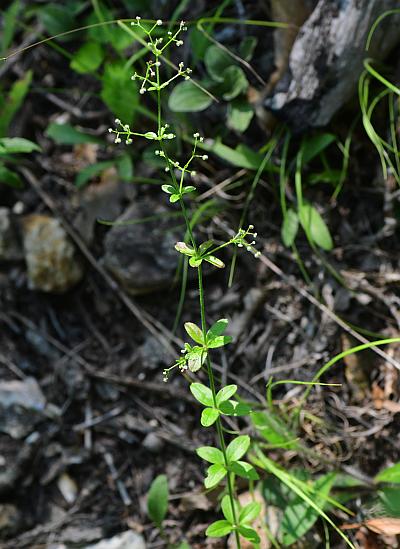Galium pilosum Aiton
Hairy Bedstraw

Native
CC = 6
CW = 5
MOC = 63
© SRTurner
Galium pilosum AitonHairy Bedstraw | |
 |
Native CC = 6 CW = 5 MOC = 63 |
© SRTurner |
|
Family - Rubiaceae Habit - Perennial forb. Stems - Lax to ascending to erect, to 80 cm, unbranched or few- to several-branched from the base, rarely also with few branches toward the tip, moderately to densely pubescent with fine, straight or curved, soft, more or less spreading hairs, rarely glabrous or nearly so.
Leaves - Whorled, 4 per node, simple, sessile, spreading in orientation. Blades 5-25 mm long, 2-14 mm wide, elliptic to oblong-elliptic or narrowly oval, rounded or more commonly angled to a usually bluntly pointed tip, the midvein occasionally extended into a minute, sharp point (especially on smaller leaves), angled at the base, the undersurface with minute, impressed, linear to oblong or circular glands, otherwise sparsely to moderately pubescent with short, fine, straight to curved hairs along and often also between the veins, the venation palmate with 1 midvein and 2 finer lateral veins, the latter sometimes obscure or produced only toward the blade base, the margins with fine, soft hairs, flat or only slightly curled under.
Inflorescence - Small panicles, terminal and axillary from the upper leaves, positioned over the leaves, 1-4 cm long, with mostly 1-3 branch points, or reduced and appearing as unbranched racemes, the branches short to relatively long, spreading to ascending. Flowers relatively few to more commonly several to numerous, the stalks 1-3 mm long (becoming elongated to 4-10 mm at fruiting).
Flowers - Corollas 1.0-1.5 mm long, 4-lobed, dark purple or maroon.
Fruits - Schizocarps 2.0-2.5 mm long, 2.5-3.5 mm wide, the surface densely pubescent with short (ca. 1 mm long), hooked hairs.
Flowering - June - August. Habitat - Mesic to dry or rocky upland forests, bases and ledges of bluffs, savannas, glade margins, upland prairies, sand prairies, streambanks, pond margins, quarries, railroads, and roadsides. Origin - Native to the U.S. Lookalikes - G. circaezans; more broadly, several other species of Galium. Other info. - This little species can be found in the southern 1/2 to 2/3 of Missouri. It also occurs in most of the eastern half of the continental U.S., with some bias toward the southeast. Interestingly, the plant is classified as a noxious weed in New York, Pennsylvania, Massachusetts and Connecticut, apparently due to its ability to colonize disturbed areas. In Missouri it is innocuous. The plant is recognized by its whorls of four leaves at a node, minute maroon flowers, and fruits densely covered with hooked bristles. At a glance it can appear quite similar to the lookalike G. circaezans, but that species has pale greenish flowers. In addition, the leaves appear different, with G. pilosum usually appearing to have only a single midvein, whereas leaves of G. circaezans are conspicuously 3-veined. Photographs taken at Little Lost Creek Conservation Area, Warren County, MO, 7-7-2020 (SRTurner). |